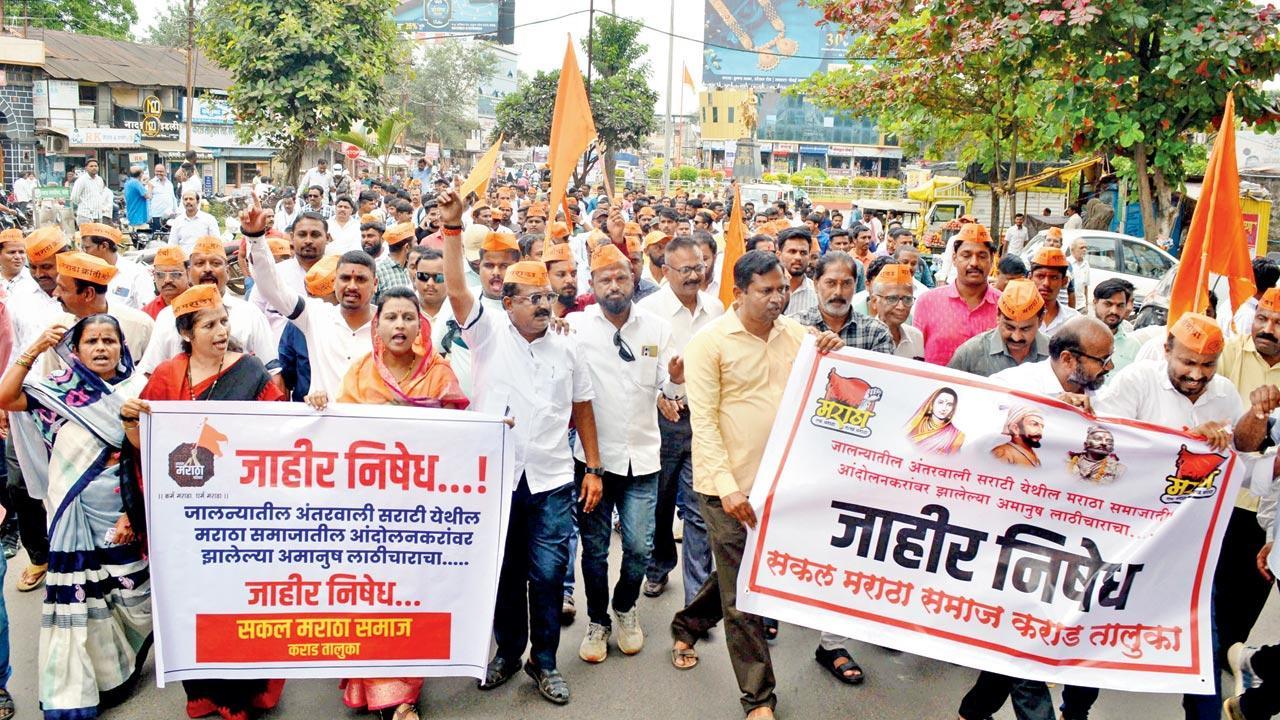Flared up by alleged police atrocities, the Maratha quota protest, admired earlier for its novel model, is expected to walk a political path ahead of the elections to be held early or on schedule

Maratha Kranti Morcha members stage a protest against the Jalna administration over a lathi-charge on protestors demanding reservation for Marathas, in Karad on September 2. Pic/PTI
 While the Opposition bloc I.N.D.I.A was deliberating its way ahead on the last day of its two-day conclave in Mumbai, the Maha Vikas Aghadi leaders got an issue on a platter to corner the Mahayuti government with. Police atrocity was alleged in controlling the Maratha quota protest in Antarwali Sarati, a small town of over 4,000 people, near Ambad in Jalna district, one of the hotbeds of a prolonged agitation. An explanation came from the government. A probe was announced and decisive action assured in ensuring the quota that has been struck down by the Supreme Court will see reality. Arguments about the reasons for the case being defeated in court resurfaced, with both the ruling and Opposition parties involved in the process of quota in their respective regimes, making noises against each other.
While the Opposition bloc I.N.D.I.A was deliberating its way ahead on the last day of its two-day conclave in Mumbai, the Maha Vikas Aghadi leaders got an issue on a platter to corner the Mahayuti government with. Police atrocity was alleged in controlling the Maratha quota protest in Antarwali Sarati, a small town of over 4,000 people, near Ambad in Jalna district, one of the hotbeds of a prolonged agitation. An explanation came from the government. A probe was announced and decisive action assured in ensuring the quota that has been struck down by the Supreme Court will see reality. Arguments about the reasons for the case being defeated in court resurfaced, with both the ruling and Opposition parties involved in the process of quota in their respective regimes, making noises against each other.
ADVERTISEMENT
The issue has flared up again, after a lull. It has never been only a socio-economic matter, but a wide platform for politics that depends on the single largest community (caste) of Maharashtra. The Maratha dominance has been a force to reckon with in Maharashtra politics, but that very influence, however, remained restricted to certain families, the community has argued while asking for reservation based on the economic and educational backwardness of the larger section of Marathas, that had been happy to have their representative as CM for decades. A non-Maratha CM is unthinkable here even now. A handful of exceptions-very recently Devendra Fadnavis and Uddhav Thackeray-ruled the state. Marathas were back in the throne with Eknath Shinde’s coronation last year. Another Maratha, Ajit Pawar, was inducted, in July this year, as the Dy CM. The then CM Prithviraj Chavan, also a Maratha, had issued an ordinance giving the community a quota, but that, too, didn’t stand the court’s scrutiny. Chavan’s successor Fadnavis came up with a quota that was ratified by the high court, but defeated in the Supreme Court when the MVA was in power.
The commission that had worked on a report emphasising a quota for the community has endorsed the community’s claim of economic and educational backwardness, based on which the state approved of a reservation in education and jobs, which later didn’t stand in the SC, because the provision had breached a legal cap of 50 per cent for social reservations.
Held in an unprecedented peaceful manner, the Maratha protest had been appreciated for its model code of conduct during the Devendra Fadnavis government. The community took out 58 silent marches without any incident or accident. Maratha politicians were not allowed to take the forefront but were told to walk in the back rows in case they wanted to show solidarity with the cause. The agitation did turn violent later, but subsided soon when the quota was approved. The MVA government faced its share of criticism when the case didn’t stand in the SC. Efforts were made to revive the reservation, with all possible legal support and accommodation of eligible Marathas in welfare schemes, but the main demand still hinges on uncertainty as the Shinde government has promised a resolution even as the Other Backward Classes (OBCs) constituents, a big congregation of several castes, fears that the Marathas will eat into their share of the quota. Some other castes were also promised a separate quota by successive governments. They too step up pressure time and again.
The legislative provisions for the Maratha quota, made first by Prithviraj Chavan in 2014, and later by Devendra Fadnavis in 2018, had come ahead of the Assembly polls, obviously to avoid the Maratha wrath. After winning the 2014 the polls separately, the BJP and Shiv Sena alliance won a majority in 2019. But the Sharad Pawar-led NCP, usually branded as the party of Marathas, increased its strength from the 2014 count, to stake a claim to power in association with the Sena and Congress.
Overall, it has been observed that Maratha votes get split because in many places the fight is between the Maratha candidates. One who gets more Marathas on his side, in addition to other caste groups, scrapes through. Considering the movements in New Delhi about holding early elections, the Maratha upsurge is now up for grabs. The police action and subsequent outcry has given the Opposition a much-wanted issue against the government, that now has two Marathas, one at the helm, and the other as the deputy.
In the Jalna incident, however, another Deputy CM Devendra Fadnavis appears to be a clear target of the Opposition that would want to consolidate Maratha votes in the run-up to the elections.
Dharmendra Jore is political editor, mid-day. He tweets @dharmendrajore
Send your feedback to mailbag@mid-day.com
 Subscribe today by clicking the link and stay updated with the latest news!" Click here!
Subscribe today by clicking the link and stay updated with the latest news!" Click here!







